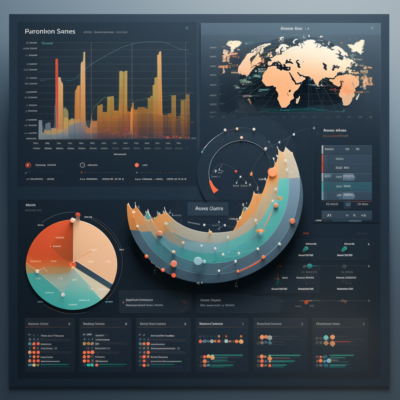
IIA’s Research and Advisory Network (RAN) clients leverage battle-tested frameworks and an exclusive network of over 150 active practitioners and unbiased experts to plan, prioritize, and execute strategic enterprise data and analytics initiatives. We regularly check the pulse of trending topics for the RAN community and facilitate critical conversations in virtual roundtable format for peer-to-peer exchange.
In a recent roundtable discussion with IIA RAN clients, data and analytics leaders from diverse industries gathered to share their challenges and successes in crystalizing the value of analytics for the business through data storytelling. The discussion covered a wide range of topics, from essential data story skills for leaders and practitioners to using AI to craft data stories.
This discussion was moderated by JP Snow, IIA Expert and Principal and Founder of Customer Catalytics. Here are the key themes and takeaways:

Research and Advisory Network (RAN)
Get access to the leading network of independent analytics expertise, allowing you to apply real practitioner insights against initiatives, projects, and problems.
1. Best Practices for Effective Data Storytelling
Participants advocate for the creation of a standardized style guide that aligns with corporate branding to ensure consistency in data presentations. This guide should highlight the necessity of clear problem statements and audience-tailored narratives to maximize relevance and minimize confusion.
Furthermore, incorporating stakeholders in the storytelling process not only bolsters collaborative efforts but also enhances the narrative by allowing those involved in the problem's inception to share practical benefits derived from analytical solutions. A business-centric approach in presentations, characterized by simplifying complex data into comprehensible visuals, helps support broader engagement and informed decision-making. Supplemental detailed slides can cater to more technical audiences without detracting from the clarity of the main narrative. To build a team of strong data storytellers, organizations should invest in structured learning and regular practice, such as visual storytelling workshops and team-based storytelling sessions, which foster an environment conducive to developing the skills necessary to effectively communicate data-driven insights that drive organizational value.
2. Essential Data Storytelling Skills
Data and analytics leaders stressed the importance of subtly guiding audiences to conclusions, enhancing stakeholder engagement and encouraging the adoption of decisions as their own. This approach minimizes resistance and promotes ownership of outcomes. Other essential skills include the ability to articulate the rationale behind data-driven conclusions clearly and the ongoing practice of storytelling techniques to refine communication skills. Functional knowledge ensures analyses are actionable within the business context, bridging the gap between technical and business-oriented perspectives. Demonstrating the practical applications and benefits of new methodologies through firsthand “early adopter” experiences within the team fosters trust and acceptance, reinforcing the value of innovative practices. Additionally, emotional engagement through empathetic communication and structured argumentation help make complex data understandable and impactful. These skills collectively enable practitioners to act as trusted advisors, driving meaningful change and enhancing the strategic impact of data across the organization.

Operationalizing Data Storytelling Webinar
With the proliferation and sophistication of self-service tools, it is likely your organization uses visually stunning dashboards to track and consume data on a variety of business functions. But to realize the full value of this data, analytics practitioners need to think like product managers and reimagine these dashboards as customer-centric, Analytic Stories ®.
3. Influencing Decision-Making Through Data Stories
The strategic use of data stories enhances decision-making processes within organizations. By co-presenting analytics alongside leaders from various departments during executive meetings, practitioners underscore the collaborative nature of data-driven insights and their impact on key business initiatives, such as improving customer centricity. This approach not only raises the profile of the analytics function but also demonstrates its integral role in achieving organizational objectives. Moreover, building trust through coherent business narratives that accompany data presentations helps secure executive buy-in for new initiatives, linking data analysis directly to tangible business benefits and fostering additional investment. Simplifying complex data to suit the comprehension levels of executives accustomed to intuitive decision-making is also crucial. By gradually introducing sophisticated data analyses and integrating them into business discussions, data professionals cultivate an environment where data-skeptic leaders can evolve into advocates of data-driven strategies. This transition is critical for embedding a robust data culture that supports continuous innovation and strategic alignment across the organization.
4. Using AI to Craft Data Stories
Discussion among data and analytics leaders revealed varied experiences and perspectives on utilizing AI to enhance data storytelling. While there is enthusiasm for the potential of generative AI, there remains a significant gap between current capabilities and the expectations of automating complex analytical tasks or weaving full data stories. AI has been effective in extracting themes from small datasets and drafting communications such as executive summaries. Participants have also used AI to better understand and tailor their data stories for certain personas (e.g. advertising executive).
5. Proactively Owning the Story Around AI
Participants discussed the importance of transparency in the data analysis process, specifically addressing the challenges data professionals face in managing perceptions of AI within organizations. A common issue highlighted was the tendency to conceal the complexities of data work to appear efficient, which can obscure the real challenges and needs of data and analytics initiatives. To enhance understanding and support for these efforts, a strategy of conducting gemba walks was suggested, involving the use of videos to demonstrate the actual challenges encountered by teams. Additionally, the discussion covered the extensive preparatory work necessary for AI to effectively analyze data, such as in customer service call transcript analysis, emphasizing the need for continuous refinement of AI prompts and demonstrating the non-trivial nature of integrating AI into business processes. By showcasing these efforts through various formats like technical demos and stakeholder collaborations, organizations can set accurate expectations and build a stronger foundation of trust and understanding toward AI-driven insights.